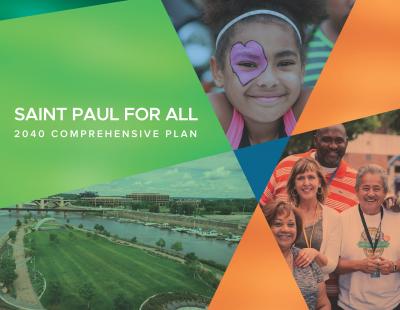 The 2040 Comprehensive Plan is Saint Paul’s “blueprint” for guiding development in the city over the next 20 years.
The 2040 Comprehensive Plan is Saint Paul’s “blueprint” for guiding development in the city over the next 20 years.
Saint Paul is a community that is welcoming to and a place of opportunity for people of all incomes, ages, races, ethnicities, and abilities. It accomplishes this by addressing the place-based dimensions of our neighborhoods: embracing growth; offering a wide range of housing choices for its diverse residents; providing a transportation system that meets the needs of pedestrians, bicyclists, transit users, riders and drivers; preserving, celebrating and building on our histories; and supporting infill development that sensitively accommodates a growing, aging and increasingly diverse population. Saint Paul is defined and enhanced by its location on the Mississippi River - an economic, environmental, cultural, historic and recreational amenity that enriches our quality of life and economic prosperity.
On November 18, 2020, after Metropolitan Council review and approval, the City Council adopted the 2040 Comprehensive Plan. Its Transportation Chapter was amended (Policy T-31 only) in 2022.
2040 Comprehensive Plan (large file: 105MB)
Chapters
The 2040 Comprehensive Plan is divided into seven main chapters including land use; transportation; parks, recreation and open space; housing; heritage and cultural preservation; water resources; and, the Mississippi River Critical Corridor Area.
Community Feedback
City staff conducted an extensive community engagement process to learn the community’s priorities for the future of Saint Paul. Staff talked to nearly 2,300 people in 2016, with a focus on reaching diverse communities.
Core Values
The 2040 Comprehensive Plan is informed by the City’s values of equity and opportunity; building on our assets; resiliency and sustainability; celebrating parks; innovation; people-centered; health; welcoming and safe; growth and prosperity through density; and, integration and coordination.
Focus Areas
To ensure the 2040 Comprehensive Plan reflects Saint Paul’s many assets both today and in the future, each chapter addresses the following focus areas: equitable cities, aging in community, community and public health, resiliency and urban design.
Navigating and Using the Plan
The Comprehensive Plan’s policies will be used to (among other purposes)inform zoning decisions, guide the expenditure of public funds, guide private investment and secure other public funding.
